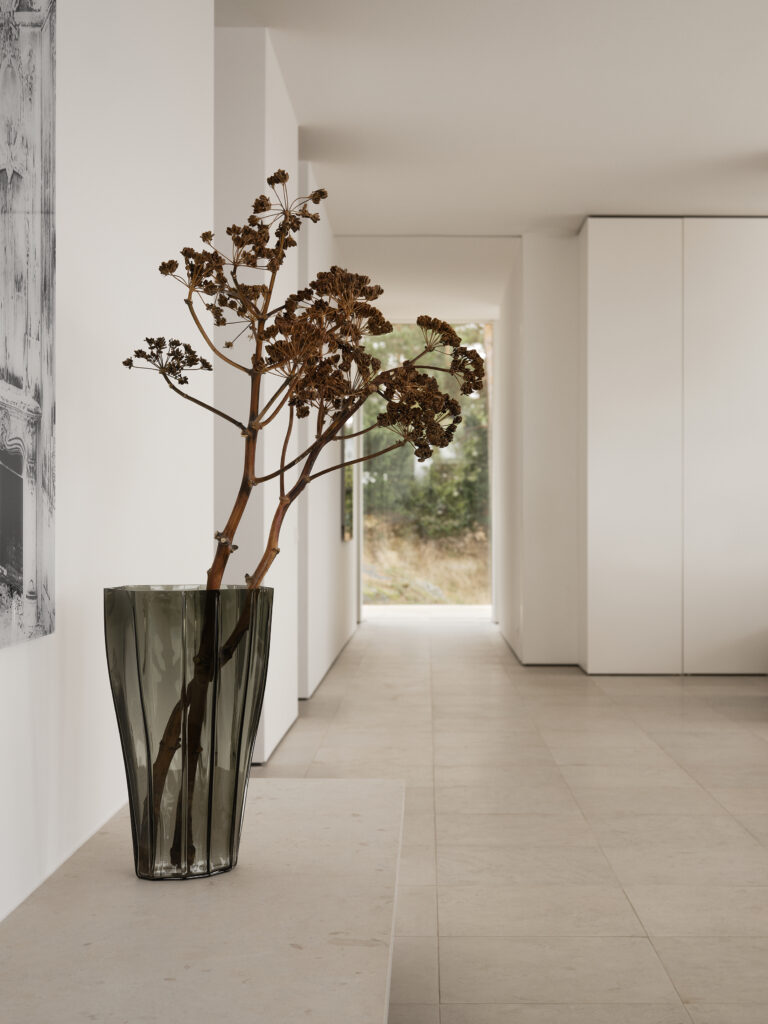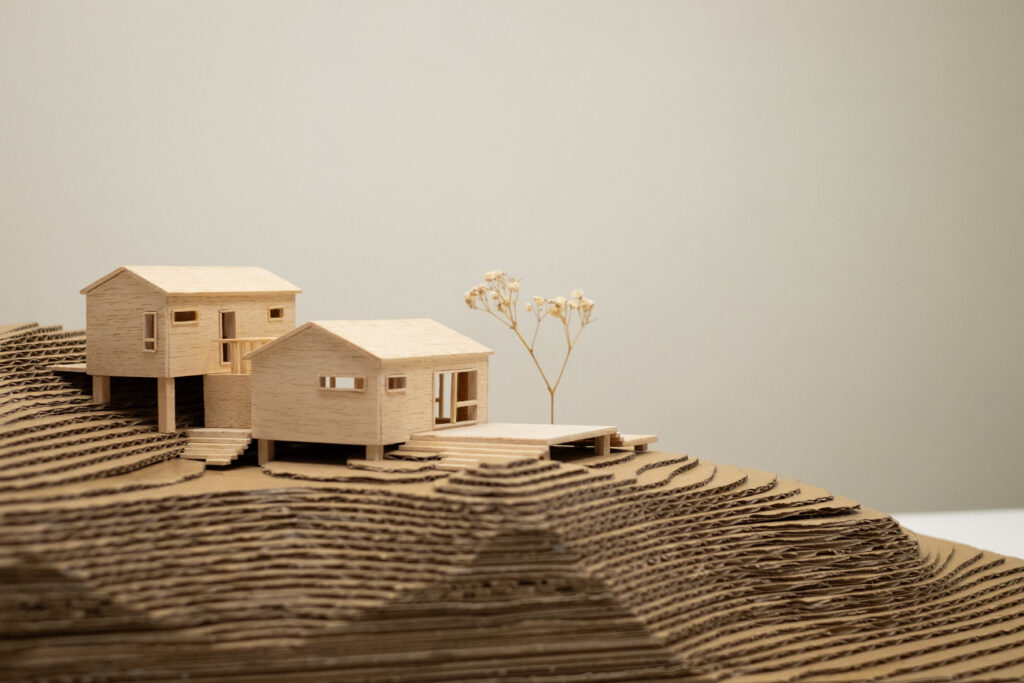Poetry is something usually digested in 2D. Typically, a poem is something of a literary work inked into parchment, sent via an envelope, scribbled onto paper, framed, laminated, or pasted to a wall.
Founder and Creative Director of Monica Forster Design Studio, Monica Forster, however, believes poetry can be captured through the three dimensional. Her designs, an expression of emotion; a thing you can hold, touch, smell or marvel.
With a mission to sustainably and seamlessly fuse form with function, Forster’s design studio interweaves emotion and a poetic sense of story in every project her team touches.
The hallmarks of Forster’s work? Sensitivity, tactility, minimal and rich in expression.

Reed Vase, manufactured by Orrefors
Operating out of her Stockholm studio – part of a 16th century brewery complete with lush gardens, an old wine cellar and greenhouse – Monica takes me through a virtual tour of the light-filled office in which her team of three works from.
A prototype chair suspends from the ceiling, a miniature model workshop lines a section of shelves, a 3D printer hums away, and Monica sits before a stained glass window.
This hub of innovation, of such modernity, set within a romantic, old-world environment perfectly encapsulates the essence of Forster’s design goals: to bring to life an inspired sense of story through new, barrier-pushing design.
Regarded as one of the top designers in Sweden, Forster says her creative family and their intrinsic connection to the Scandinavian landscape were an early influence on her career today.
“I grew up in quite an artistic environment, my father and mother had a restaurant in Lapland, where my father was the chef, and my mother worked in the hotel and restaurant,” she says.
“They were very experimental in their work – going into the forest, collecting herbs, having their own garden, growing, experimenting and so on.”
“I think that I was interested in that at an early age, [but] I didn’t know exactly what I was [going to do]. I could have become an artist… but I’ve always had an interest in expressing myself in a three dimensional way. I think that was sort of my medium.”

Muse Sofa & Ottoman, manufactured by Artifort
Having been exhibited both in Sweden and internationally, across prominent institutions such as MoMA in NYC and VA Museum in London, Forster’s design portfolio spans furniture, objects, spaces, creative direction for brands and the recent addition of private commissions, in which she works on creating custom-designed objects and functional art pieces for her clients.
Forster’ process for each design involves diving deep into her client’s history and the unique aspects of a company, which help her to create work that enhances their company story and moves it into the future.
Here, it’s about digging for even the smallest of important details through sometimes curious methods.
“I start out with doing research on the company in different ways, and then I try to take a step out and think about the feeling that I get and what we can contribute with,” she says.
“When, when we are given a brief, I, if it’s a new client, want to go and visit the company… and when I arrive, I talk to the driver that picks me up in the airport.
Why the driver? Well, Forster values the wisdom and potential of every member in her clients’ teams. Especially the family-oriented companies who value the importance of long-term employee relationships.
“Usually the driver, that person that picks you up, has been in the company for a long time, and they know a lot about the company… I usually get a lot of good knowledge in that hour or so, going to and from.”
Five-time winner of ‘Designer of the Year’ in Sweden and most recently honoured with “AW Designer of the Year 2023” by AW Architektur & Wohnen, Forster explains that while awards and recognition are appreciated, the real success comes from the creative process and the ability to work on meaningful projects. That’s where the joy is found.
“Ever since I started to work, it’s been about the process,” she explains.
“For me, it’s been about exploring new things, about materials and about experiments – that’s how I did my very first project, I experimented.”
“It’s really been about working, being inside the process, creating and the creativity – and and then if that leads to success it’s really wonderful, but it doesn’t… I’m not in it for the success.”
Forster’s prioritisation of the creative process taking precedence over external metrics of success can be demonstrated through a line of chairs Forster designed with another producer in 2012, that were developed to ergonomically suit the feminine form.
It surprises me when she shares that the reception to a chair designed with women’s bodies in mind was wholly negative; facing resistance due to gender discourse at the time.
To this day, Forster believes it was a “caring” project that might have been embraced if it had of been released today.
“I just thought [it was] such a beautiful idea, and that no one had really thought about it in that way,” she shares.
“Men and women have a different ergonomy and different bodies, and… to make a work chair that is aimed for women… I mean, if you think about it, it feels like it would be quite natural to do something like that, because more or less, all the chairs that are out on the market are aimed for men.”
“It raised the question, why should we have something different than men? It just became this whole other issue, not about the chair itself, but… for me, it’s like a non question, because, you know, if it’s a good chair, why not just embrace it? I still think that it’s a really, really nice idea.”
Context and timing are key, and how society shifts over time, plays a large factor in Forster’s designs.
For the line of study chairs for women, social understandings of gender equity in the 2010’s played a role in its reception.
“It’s the world that we live in. [The reception of a design] is a lot about the timing on different projects,” she adds.
Forster has found that her work in furniture, which intrinsically shapes our living environment, is also influenced by timing.
When designing furniture for the home, Forster considers the changing nature of home life over time and as a result, the need for new pieces to accommodate the evolution of home activities – interactions that readily shift due to the rapid impact of technology.
“The way that people live in houses and apartments have maybe changed a bit,” she muses.
“You have a family, maybe it’s like the children are on the sofa with the mobile phone. Someone is cooking, someone is on the kitchen table with the computer. Someone else is somewhere else in the apartment listening to music, for example, and so on.”
“All the new technical aspects of life has, of course, also changed the way that we interact with each other and and [as a result] we have new ways of interacting and being in the same room at the same time…for that, of course, there needs to be new types of furniture created.”

Forster’s key design ethos is to innovate and push creative boundaries, to transcend functionality and balance poetic, artistic sensibility with pragmatism, all while remaining anchored in sustainability.
“We try to find a gap which hasn’t been filled… and that can be done in many different ways, depending on what kind of company [we are working for,” she explains.
“It could be [the use of] different techniques, different types of expressions or materials, different use of materials, and sustainability is always a part of everything that we do.”
After designing an expanded line of cutlery, steel products and ceramics with prominent Swedish cutlery brand Gense that used 96% recycled steel, Forster has headed up a secondary line of items with Gense that will utilise 98% recycled materials.
The finished Torö Vacation House
Forster shares that hanging her studio’s hat on designs created with longevity in mind, roots every aspect of her output into a high standard of sustainability.
“It has always been in the DNA of the studio to design things that aren’t trendy,” she says.
“We design things that last for a very, very long time… so we try to be quite classic, but still with something that catches the heart or catches the poetry of the piece.
“It’s a very good way of being sustainable, because doing something that stays on and on and on is really more or less the best.”
Having just finished designing Torö Vacation House, there are many (confidential) exciting projects on the horizon for Monica Forster Design Studio.
Her advice for young designers wanting to trailblaze in the manner she’s done so far? Forge your own path with confidence.
“Do not listen to any advice and work very hard,” she says.
“Don’t listen when someone says it cannot be done.”


